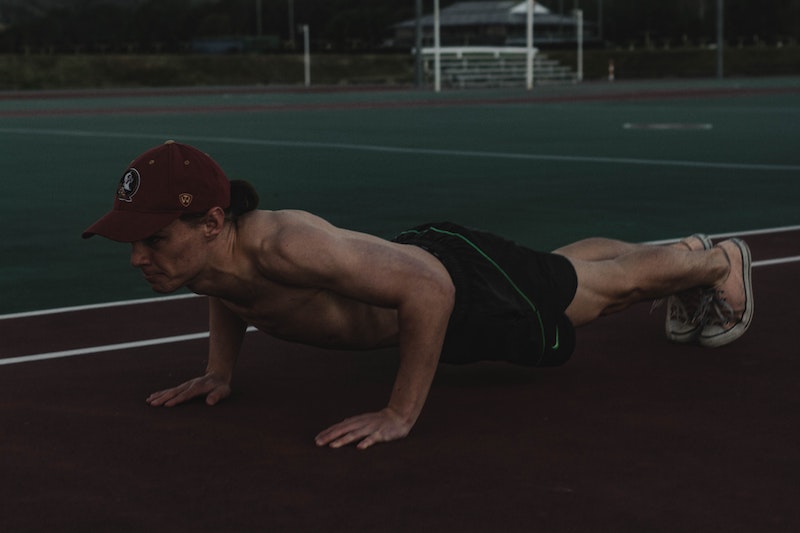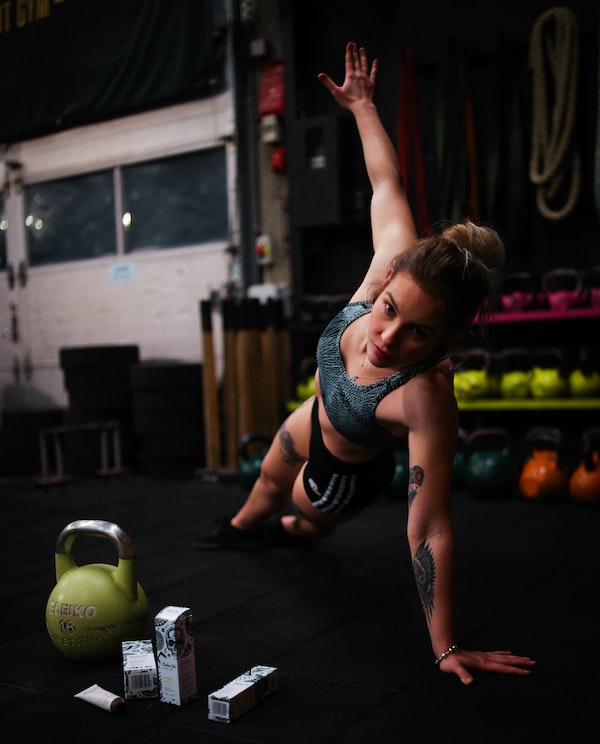High-intensity interval training, also known as HIIT, has been all the rage the last few years.
It consists of intense bursts of exercise followed by short recovery periods. The purpose is to constantly keep your heart rate elevated and burn more fat.
Here’s just one example of a type of HIIT workout you can do just about anywhere:
- 50 sit-ups
- 40 jump squats
- 30 push-ups
- 20 split jumps
- 10 tricep dips
- 30 second burpees
To get the full effect of the workout, you need to give 100% of your energy during each cycle. Additionally, there should only be about 30 seconds of rest between each workout.
But let’s get into the big question: How long does it take for HIIT results? What kind of results can you see from 1 month of HIIT workouts?

For the best HIIT before and after results, you should complete a workout like this one a few times per week. In just one month, you should be able to see the beginnings of some stellar results.
After one month or 30 days of regular HIIT workouts your endurance will improve dramatically. You’ll be able to complete the workouts with much greater ease, and the extra energy will likely carry over into your regular life. You’ll feel great!
HIIT is also a great way to burn calories, which can help you lose fat — provided you’re eating properly and creating a calorie deficit. There is some evidence that HIIT is better for burning fat than many other types of exercise, all other factors being equal.
However, don’t expect jacked, rippling muscles after just 1 month of high intensity interval training. HIIT isn’t the best mass builder around, however if you stick with the program and eat properly, you’ll lose a lot of fat and reveal excellent muscle tone over time.
I spoke with several people about their experiences with HIIT workouts and how long it usually takes to see HIIT results.
30 days may not seem like that long of a time, but it’s enough to make some drastic changes to your body.
Weight Loss

At first glance, it would seem that HIIT workouts go against common beliefs about losing weight.
After all, you may only perform high-intensity training 10-20 minutes a day rather than an hour.
But the truth is that you can lose weight faster with less work because the exercise you’re committing to has greater intensity.
According to Healthline, HIIT workouts are more effective at depleting oxygen available to your muscles. This forces your body to burn fat to obtain energy instead.
Not only that, but your body will continue burning calories even after the workout is over. The reason for this is that your body is operating at an oxygen debt.
However, you shouldn’t expect to go down a whole size after just one month of HIIT workouts.
Carly James, a fitness instructor and freelance writer for Fitness Authority, writes, “Certainly, no matter your level, you’ll be in a better position then when you started, this is almost certain.”
She adds that some people might lose several pounds right away. Others may swap some fat for muscle and not see the scale move at all. But either way:
“You’ll certainly be able to notice a better overall physique in the mirror within 30 days.”
And of course, your weight is also dependent on other factors, such as diet and genetics.
You just need to be patient if you don’t see the results you want right away. That’s what happened with Nancy Baker from Child Mode.
She shared her experience, writing, “One of the trainers at the gym suggested I do HIIT with a little bit of weight training for toning my muscles. I agreed and did HIIT along with training for over 3 months until I saw some results and my belly started to look better. It took that long but I was finally getting thinner but stronger.”
It may take a few months, but the results are worth it as long as you stick to it.
Hannah Daugherty, CPT-NASM and fitness expert with Fitter Living, adds:
“When it comes to weight loss (if you’re actively trying to lose weight), you might notice that you are losing quite a few pounds initially, and then that tapers down and can plateau around 1-2 pounds a week…and that’s okay, especially if you’re trying to keep it off for the long haul!”
Soreness
You can always expect some soreness with a new workout regimen.
However, considering how intense HIIT workouts can be, you definitely need to be prepared before jumping in headfirst.
One common effect of HIIT workouts is delayed-onset muscle soreness where you feel sore 48 to 72 hours after the workout.
If the soreness persists for longer than 72 hours, then you may have a strain or muscle tear.
Generally, an off day or some active recovery like walking, jogging, or stretching is enough to improve the soreness.
It’s for this reason why most people will do well to engage in HIIT workouts only two or three days a week to start. It’s particularly important to pace yourself if you’re not used to working out all the time.
Professional basketball player and ISSA certified personal trainer Adam Kemp said as much:
“Your muscles will adapt to create a more lean and toned physique. Along with that, it is very likely that you will see an increase in energy each day, even though you’ll probably have more muscle soreness (DOMS) than before beginning.”
To recap, a little soreness for the few couple of weeks to 1 month of HIIT is to be expected. Take care of yourself and avoid overexerting yourself too much.
It does get easier as long as you stick with it.
(Read my guide to what to do about sore legs in particular.)
Endurance
Having more energy throughout the day is a major reason why people want to work out more.
HIIT is especially well-suited to improving your endurance and daily energy.
The reason you enjoy greater endurance over time is that you are building up an array of muscles. You’re performing a high-intensity workout that keeps your body guessing, and once you get the hang of it, you can increase the level of intensity for each exercise.
The best part is that this is one benefit you should begin to notice after one month… if not even more immediately.
Tim Bigknee, a personal trainer at Sights and Insights, wrote:
“Increased endurance will make daily activities easier, carrying groceries, running for the bus, and walking upstairs will be noticeably easier after a month of HIIT.”
You’ll feel better and be able to do more in the day thanks to HIIT.
Muscle & Strength
HIIT is a great way to become stronger and more athletic.
Just don’t expect to get huge muscles.
Dr. Len Lopez writes:
“HIIT workouts are NOT good for people who want to bulk up and add lots of muscle and want to be on the cover of muscle magazines.”
The reason? Progressive overload (the key to muscle growth) is difficult to achieve with HIIT.
You can do weighted HIIT exercises, but with an emphasis on tempo and short rest periods, it’s difficult to lift heavy enough and hard enough to drive muscle growth.
However, you can develop solid strength and muscle tone with just bodyweight or lightly weighted HIIT workouts. Pair this with solid fat loss, and you can get a really well-sculpted body.
Dr. Lopez writes that HIIT, done properly, will probably give 80% of the population the exact physique result they’re looking for.
Just don’t expect it all to happen right away.
In your first month, you can lose a couple of pounds of fat (if you’re eating right) and get dramatically stronger on bodyweight movements like squats and push ups.
You’ll look more athletic and toned, but hardly super muscular.
(For more muscle growth, try strength training with calisthenics.)
Mind & Mood
Almost all exercise is good for your mental health, and this is no exception. Your HIIT before and after transformation won’t be just physical.
As Carly James stated, “It encourages the production of serotonin (aka the ‘happy hormone’).”
The same can be said about HIIT workouts.
There’s a great sense of accomplishment to achieving something. Once you’re done with HIIT and you’re sweating and breathing hard, you’ll really feel like you got in a great workout.
And the best part is you probably finished it in less than 30 minutes.
It’s also important to point out that the University of Texas conducted a study that found that high-intensity workouts can boost a protein in your brain called BDNF.
This protein is associated with mood regulation and cell repair. Low levels are connected with depression and schizophrenia, so increasing its presence may help individuals prone to those conditions.
You should notice a boost in your mood immediately after a workout.
30 days of committing to an intense workout will definitely leave you with a sense of pride in what you have accomplished.
ACE-certified trainer Lynn Montoya writes:
“There’s a definite improvement in people’s energy levels – I had one woman tell me that after a few weeks of HIIT she feels happier.”
Not a bad result at all!
Wrapping Up
HIIT is not for the faint of heart.
The workouts may seem short and not all that intimidating, but they are INTENSE.
And that’s for a reason.
Practice HIIT two or three days out of the week, especially if you haven’t really exercised any other way recently. After 30 days, you should start to see some improvements.
You can ramp up the frequency and difficulty from there.
While you may not lose a ton of weight or build up muscles right away, you’re laying the foundation of great things to come. It may be more around the three-month mark when you notice more definition in your muscles. The vital thing is to commit and regularly perform HIIT workouts.
For more, check out the pros and cons of HIIT workouts here.
And if you’re interested in a lower impact form of exercise, then check out what you can accomplish after 30 days of pilates or yoga.